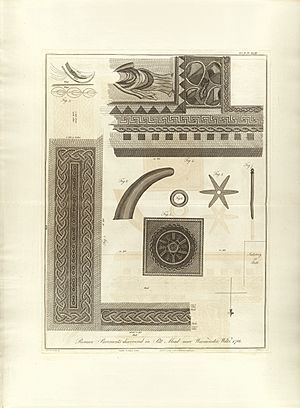Daines Barrington facts for kids
Quick facts for kids
Daines Barrington
|
|
|---|---|

Engraving from a 1770 painting
|
|
| Born | 1727/28 |
| Died | 14 March 1800 |
| Nationality | English |
| Alma mater | The Queen's College, Oxford |
| Occupation | Lawyer |
| Known for | Correspondence with Gilbert White |
Daines Barrington (born 1727 or 1728, died 1800) was an English lawyer. He was also very interested in old things (an antiquary) and nature (a naturalist). He exchanged many letters about nature with his friend, Gilbert White.
Barrington was a Vice President of the Royal Society, a famous science group. He studied many science topics, like how young birds learn their songs. He also created a special way to record information about weather, plants, and birds. Gilbert White used this method too. Barrington even wrote about amazing child geniuses, including Wolfgang Amadeus Mozart, who visited England when he was nine.
Contents
Early Life and Legal Career
Daines Barrington was the fourth son of John Barrington, 1st Viscount Barrington. He started studying at The Queen's College, Oxford, in 1745. However, he did not finish his degree. In the same year, he began studying law and became a lawyer in 1750.
He held several important legal jobs. He was a judge in North Wales starting in 1757. He also worked as a judge in Bristol and Chester. Barrington wrote a well-known book called Observations on the Statutes in 1766. This book was popular among historians. He stopped working in law in 1785. He kept a job as a manager of supplies in Gibraltar, which gave him a good income.
Exploring History and Science
Barrington was very curious about history and science. In 1773, he published a book by Paulus Orosius. It included an old English version by King Alfred the Great and Barrington's own notes. He also wrote about the chances of reaching the North Pole in 1775. This was after Captain Constantine John Phipps went on a journey to the North Pole.
Many of Barrington's other writings appeared in the publications of the Royal Society and the Society of Antiquaries of London. He became a member of both groups in 1767. Later, he became a vice-president of the Society of Antiquaries. He collected many of these papers in a book called Miscellanies on various Subjects (1781).
Studying Child Geniuses
Barrington wrote about the nine-year-old Wolfgang Amadeus Mozart's visit to London in 1764. This writing first appeared in a science journal in 1770. Later, it was included in his Miscellanies book. He also wrote about other talented children, like William Crotch and the Wesley brothers.
Barrington described his time with Mozart:
- "I asked him to compose a Song of Rage for an opera.
- The boy looked at me cleverly and began a short, angry song.
- He played the harpsichord with such passion, like someone possessed.
- He even rose from his chair while playing.
- I was told by musicians that when a famous composer named Bach stopped playing a complex piece, little Mozart could continue it perfectly.
- I saw most of these amazing things myself. I wondered if his father was lying about his age.
- But Mozart looked and acted like a child. For example, while he was playing, a cat came in. He immediately stopped playing and ran to the cat. We had trouble getting him back to the harpsichord."
Bird Behavior and Migration
Barrington also studied birds. He wrote about how birds sing and even about their language. He tried an experiment where he raised young linnets (a type of bird) with different foster parents. He found that these linnets could learn the songs of other birds, like larks.
However, Barrington did not believe that birds traveled long distances (migrated). He thought that swallows, for example, slept underwater during winter. This idea was common a long time ago.
Working with Gilbert White
Many letters from the parson-naturalist Gilbert White to Barrington are in White's famous 1789 book, The Natural History and Antiquities of Selborne. Barrington's letters to White are not in the book.
Barrington created a special "Naturalist's Journal" format. This journal helped people record daily observations about weather, plants, birds, and insects. Gilbert White used this journal format to study nature in his village of Selborne. Barrington is seen as a pioneer in the study of phenology, which is about how nature changes with the seasons.
The Cornish Language
Barrington met Dolly Pentreath, a speaker of the Cornish language. He wrote about their meeting. His report is the main source for the idea that Dolly was the last person to speak Cornish. However, after Dolly died in 1777, Barrington received a letter. It was written in Cornish and English. The letter said that five other people in the village of Mousehole could speak Cornish. Barrington also mentioned another native Cornish speaker, John Nancarrow, who lived until the 1790s.
The plant group Barringtonia is named after Daines Barrington.
Death and Burial
Daines Barrington never married. He lived most of his life in London. He became ill and could not move his legs. He died on March 14, 1800, after being sick for a long time. He was buried in the vault of the Temple Church.
Notable Works


